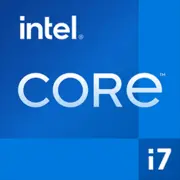Intel Core i7-11600H

Intel Core i7-11600H: A Balance of Power and Mobility in 2025
An analysis of the processor for those seeking a versatile laptop
Architecture and Process Technology: 10nm SuperFin and New Horizons
The Intel Core i7-11600H processor, released as part of the Tiger Lake line, represents an important step in the evolution of mobile CPUs. Its Willow Cove architecture, built on a 10nm SuperFin process, ensures high transistor density and energy efficiency. This allows for 6 cores and 12 threads with a base frequency of 2.8 GHz and turbo mode up to 4.6 GHz. Key features include:
- 18MB L3 cache — accelerating access to frequently used data.
- Integrated Intel UHD graphics for the 11th generation — 32 execution units (EUs), supporting 4K@60Hz and HDMI 2.0.
- Support for PCIe 4.0 — fast data transfer for SSDs and external devices.
The Willow Cove architecture also improves branch prediction and security (for example, Control-Flow Enforcement technology). While the integrated GPU lags behind discrete graphics cards, it handles light gaming and video rendering up to 1080p well.
Power Consumption and TDP: Is 35W the Limit?
The nominal TDP of the processor is 35W, but in reality, power consumption can reach 45–50W in turbo mode. This creates a load on the cooling system, especially in thin laptops. Intel, however, compensates for this with technology:
- Intel Dynamic Tuning 2.0 — adaptively adjusts power based on load.
- Turbo Boost Max 3.0 — automatically boosts the most powerful cores.
For users, this means that for office tasks, the CPU operates in a power-saving mode, while rendering or gaming allows it to unleash its potential, provided the cooling system can handle it.
Performance: From Excel to Cyberpunk 2077
Office Work and Multimedia:
- Running 20+ browser tabs + streaming video — no lag.
- Rendering 4K video in Premiere Pro: 15–20% faster than the i7-10750H (Comet Lake).
Gaming:
- In games with integrated graphics (such as CS:GO, Dota 2) — stable 60–80 FPS on medium settings.
- Paired with a discrete graphics card (NVIDIA RTX 3050) — comfortable gaming in AAA projects on high settings (Full HD).
Turbo Mode:
Under load, the processor can briefly hold frequencies up to 4.6 GHz, but after 2–3 minutes, it may throttle in compact cases. In gaming laptops with quality cooling (e.g., MSI Katana GF66), the performance drop is minimal.
Use Cases: Who is the i7-11600H Suitable For?
- Students and Office Workers: Multitasking, document handling, and video conferencing.
- Creative Professionals: Video editing, 3D modeling (especially in conjunction with discrete GPUs).
- Casual Gamers: Gaming at medium settings or with an external graphics card.
The processor is not suitable for heavy 8K rendering or 240Hz streaming — for such needs, it's better to opt for models with 8+ cores (e.g., AMD Ryzen 9 6900HX).
Battery Life: How Long Will the Battery Last?
With a TDP of 35W, laptops equipped with this CPU typically have batteries ranging from 50 to 70 Wh. Results:
- Office mode (50% brightness, Wi-Fi): 6–8 hours.
- Video playback: Up to 5 hours.
- Gaming: 1.5–2 hours.
Power-saving technologies:
- Intel Speed Shift — instant switching between modes.
- Windows 11 Optimization — background process suspension.
Tip: choose models with a battery capacity of 60 Wh or more and fast charging functionality.
Comparison with Competitors: AMD, Apple, and Previous Generations
- AMD Ryzen 5 5600H (Zen 3): Cheaper by $50–100, but weaker in single-threaded tasks (Geekbench 6 Single Core ~1600). Better suited for multi-threaded workloads.
- Apple M1: More energy-efficient (up to 18 hours of battery life), but limited compatibility with Windows software.
- Intel Core i7-11800H (Tiger Lake): 10–15% more powerful, but with a TDP of 45W — leading to higher heat output.
In 2025, the i7-11600H remains relevant in the budget segment of gaming and business laptops.
Pros and Cons: Is It Worth Buying?
Strengths:
- High single-threaded performance.
- Support for Thunderbolt 4 and PCIe 4.0.
- Optimal for hybrid tasks (work + gaming).
Weaknesses:
- Heating in thin cases.
- Integrated graphics are weaker than AMD Radeon Vega.
Recommendations for Laptop Selection
1. Type of Device:
- Ultrabook (e.g., ASUS ZenBook 14): Emphasis on portability, but may experience throttling.
- Gaming Laptop (Acer Nitro 5): Better cooling, but weight from 2.2 kg.
- Workstation (Lenovo ThinkPad P15): Maximum reliability and upgradeability.
2. What to Look For:
- Cooling system (at least 2 fans + copper heat pipes).
- RAM: 16GB DDR4-3200.
- SSD: NVMe PCIe 4.0 (speeds starting from 3GB/s).
3. Prices in 2025:
- Basic models: $800–1000.
- Premium segment: $1100–1400.
Final Conclusion
The Intel Core i7-11600H in 2025 is an excellent choice for those seeking versatility without overpaying for top-of-the-line components. It is suitable for:
- Users needing power for work and casual gaming.
- Those valuing portability but unwilling to sacrifice performance.
Key benefits include support for modern interfaces, a balance of price and quality, and compatibility with the Windows ecosystem. If your budget is limited to $1000–1200, this processor is a reasonable compromise.
Basic
CPU Specifications
Memory Specifications
GPU Specifications
Miscellaneous
Benchmarks
Compared to Other CPU
Share in social media
Or Link To Us
<a href="https://cputronic.com/en/cpu/intel-core-i7-11600h" target="_blank">Intel Core i7-11600H</a>